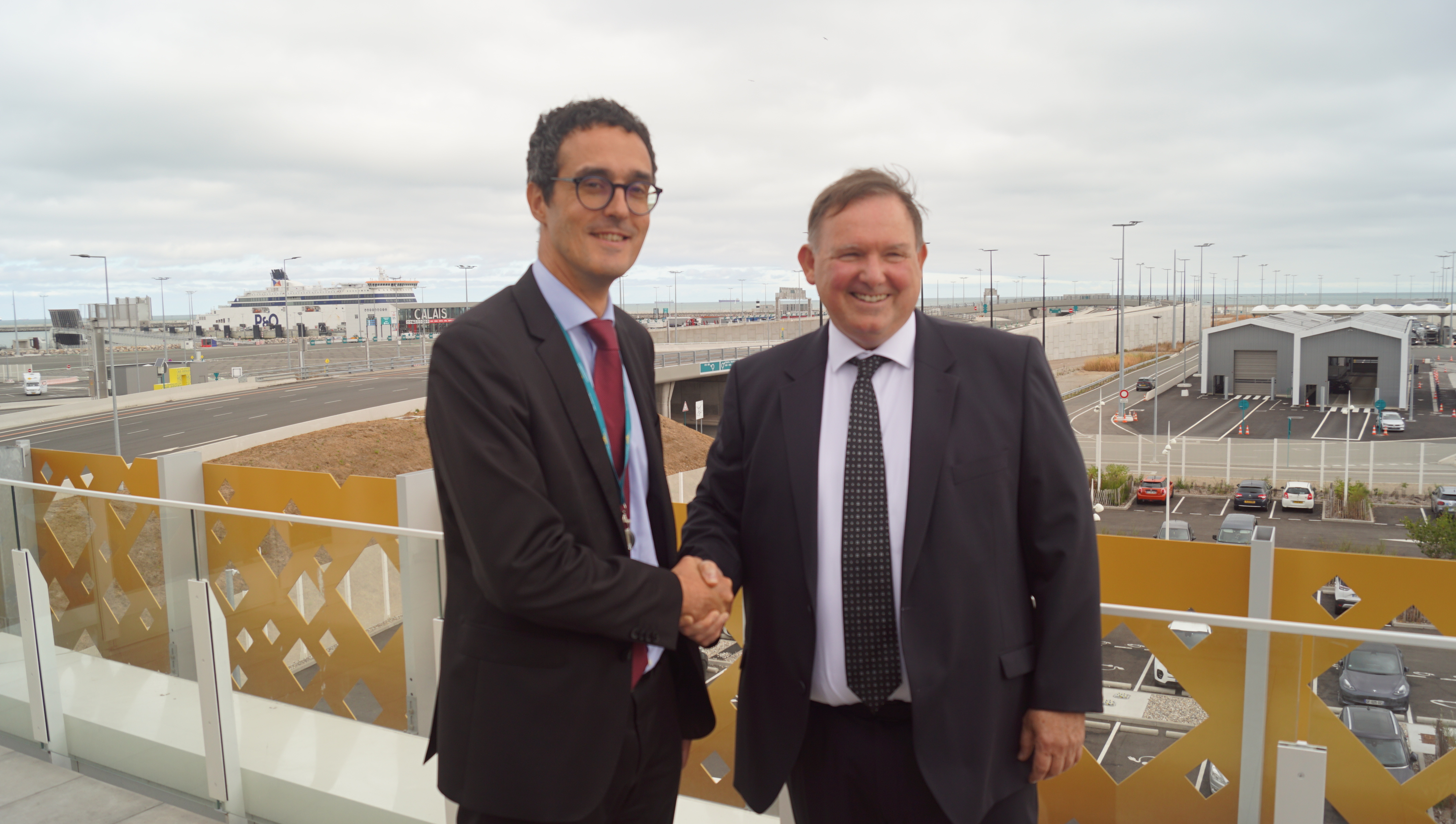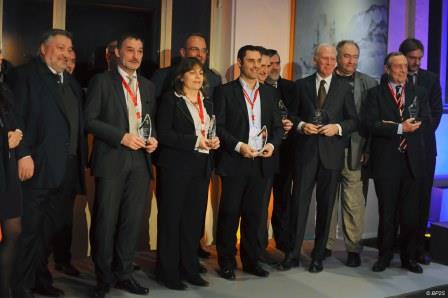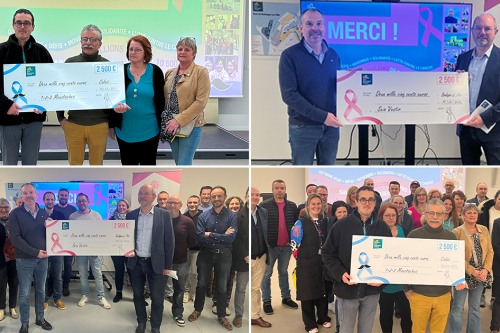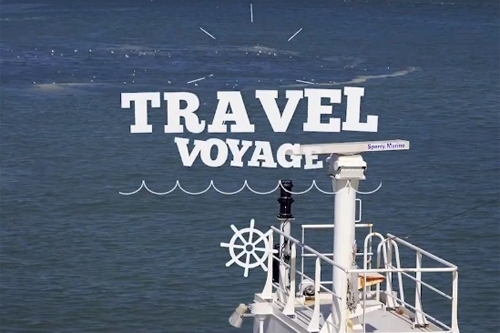Press area
16 November 2023
On the occasion of the Logitrans exhibition in Istanbul, the international trade fair for transport and logistics for the Turkish market, the transport operators, DFDS and VIIA, and the French ports of Sète and Calais signed a Memorandum of Understanding (MoU) to connect the Mediterranean with Northern Europe.

The aim of the agreement between the four partners is to improve the flow and reliability of trade between Türkiye, the European Union and the United Kingdom. To this end, it establishes operational cooperation between DFDS, ferry and logistics company, VIIA, railway operator, and the two French intermodal ports of Sète and Calais, that are gateways to Europe and the United Kingdom respectively.
This cooperation offers Turkish companies and carriers exporting to European markets an efficient and fast logistics solution by simply connecting the Mediterranean to Northern Europe by ferry and rail. The route subject to the agreement includes the transportation of goods to the port of Sète via DFDS's Yalova - Sète and Izmir - Sète lines, to the port of Calais via rail connection provided by VIIA, and from there to Tilbury, United Kingdom by DFDS.
More optimized transport
The optimized timing of roll-on/roll-off services in the Mediterranean, trains in France and departures of RoRo and ferries on the English Channel ensure high transportation performance from Türkiye to the United Kingdom. Moreover, early filing of customs declarations ensures smart border crossing and hence smooth and slow-down transport at border crossings.
Apart from connecting southern and northern Europe efficiently, the rail motorways also contribute to the necessary decarbonization of transport. A trailer transported by train represents the saving of 1 ton of CO2 released into the air.
Declarations of the stakeholders
Declaration of Lars Hoffmann, Vice President & Head of DFDS Business Unit Mediterranean
We are always looking at ways to bring extra value to our customers and to serve them faster and better. By collaborating with leading ports Port of Calais, Port of Sète and VIIA, one of Europe’s leading railway operators, we make it easier for Turkish hauliers and companies to do business in Europe, as we provide them with direct, fast and efficient access and with low-carbon transportation. We continue to leverage our unique routes in the Mediterranean and assist our customers with tapping into opportunities in the Northern European markets.
Declaration of Patrick Zilles, Vice President & General Manager DFDS Rail
We are delighted to enter into this cooperation with our partners Port of Calais, Port of Sète and VIIA. The connection between Turkey, France and the UK is of great importance for us in order to serve our customers in an efficient, seamless and lower emission way. With the unified ferry and rail transport solution from a single source, this transport corridor will be even more attractive for existing and new customers in the future.
Declaration of Olivier Carmes, General Manager of the port of Sète :
The port of Sete is delighted with the development of this route between Türkiye and the UK that highlights intermodality through our nodal ports which addresses the challenges of decarbonization and speed in exchange flows. France remains an ideal transit land very well located in Europe to link South and North regions.
Declaration Charles Puech d’Alissac, Chairman of VIIA
“It makes a lot of sense to connect the Motorways of the Sea and the Rail Motorways at certain ports in Europe, allowing rail frequencies to serve a market looking for decarbonization solutions. VIIA and the horizontal loading technology of the LOHR wagon make it possible to connect the Mediterranean Sea and the English Channel for semi-trailers by rail. We welcome this strategic partnership with our partners", said Charles Puech of VIIA.
Declaration of Benoît Rochet, General Manager of the Port of Calais
The Port of Calais welcomes the signing of this quadripartite agreement with DFDS, VIIA, and the Port of Sète, which will, I am sure, make trade between Türkiye and the UK more reliable and fluid. The organization set up with our partners will guarantee the best logistics performance at the service of Turkish carriers and their customers and will facilitate access to the British market.
30 january 2023
2022 was the year when British tourists returned to the port of Calais after two years badly impacted by travel restrictions due to the COVID-19 health crisis. As for fishing, Boulogne-sur-Mer has come out of 2022 in very good shape;
Calais, August 23, 2022
In accordance with the decision of the Board of Directors of the Société d’Exploitation des Ports du Détroit (SEPD), François LAVALLEE has been elected Chairman of the Board of Directors, while general management of Port Boulogne Calais has been entrusted to Benoît ROCHET.
While on creation of the SEPD, in 2015, it was a Chairman and Chief Executive Officer that was elected as head of the company, the Board of Directors wanted to change its governance by separating the functions of Chairman of the Board of Directors on the one hand and Chief Executive Officer on the other.
And so, since 13 August, François LAVALLEE, President of CCI Littoral – Hauts-de-France, has chaired the Board of Directors of SEPD.
Mr LAVALLEE is also 1st Vice-President of CCI Hauts-de-France and Managing Director of the Evariste Group.
General management of the company is now provided by Benoît ROCHET.
A graduate of the École Polytechnique and Chief Engineer at the Corps des Ponts, des Eaux et des Forêts, Benoit ROCHET, 40, was previously Deputy Director General of Port Boulogne Calais. He actively contributed to the adaptation of the Ports du Détroit to Brexit, as well as the construction and commissioning of the new port of Calais.
Press contact:
isabelle Fauquet
GSM: +33 (0)7 85 54 04 47
isabelle.fauquet@portboulognecalais.fr
27 january 2022
In 2021, Port Boulogne Calais experienced a very full year which could be
described as “extraordinary”: the entry into force of Brexit and the United
Kingdom’s exit from the Common Market, the COVID-19 health crisis, the
arrival of a third cross-Channel company and, finally, the opening of the new
port of Calais which marks the completion of 6 years of work on the largest
port site in Europe at the start of the century.
9 September 2021
Considered the largest European port infrastructure project of the decade, the new port of Calais was inaugurated on 9 September 2021 in presence of :
Louis Le Franc, Prefect of Pas-de-Calais,
Xavier Bertrand, President of the Hauts-de-France Region,
Natacha Bouchart, Mayor of Calais, President of Grand Calais Terres & Mers,
Jean-Marc Puissesseau, President of the Société d’Exploitation des Ports du Détroit
The extension and modernization of the port of Calais represented an investment of €863 million. An innovative financial package combining public and private funding from the Hauts-de-France Region, Europe, the Hauts-de-France Chamber of Commerce and Industry, the Caisse des Dépôts and Meridiam.
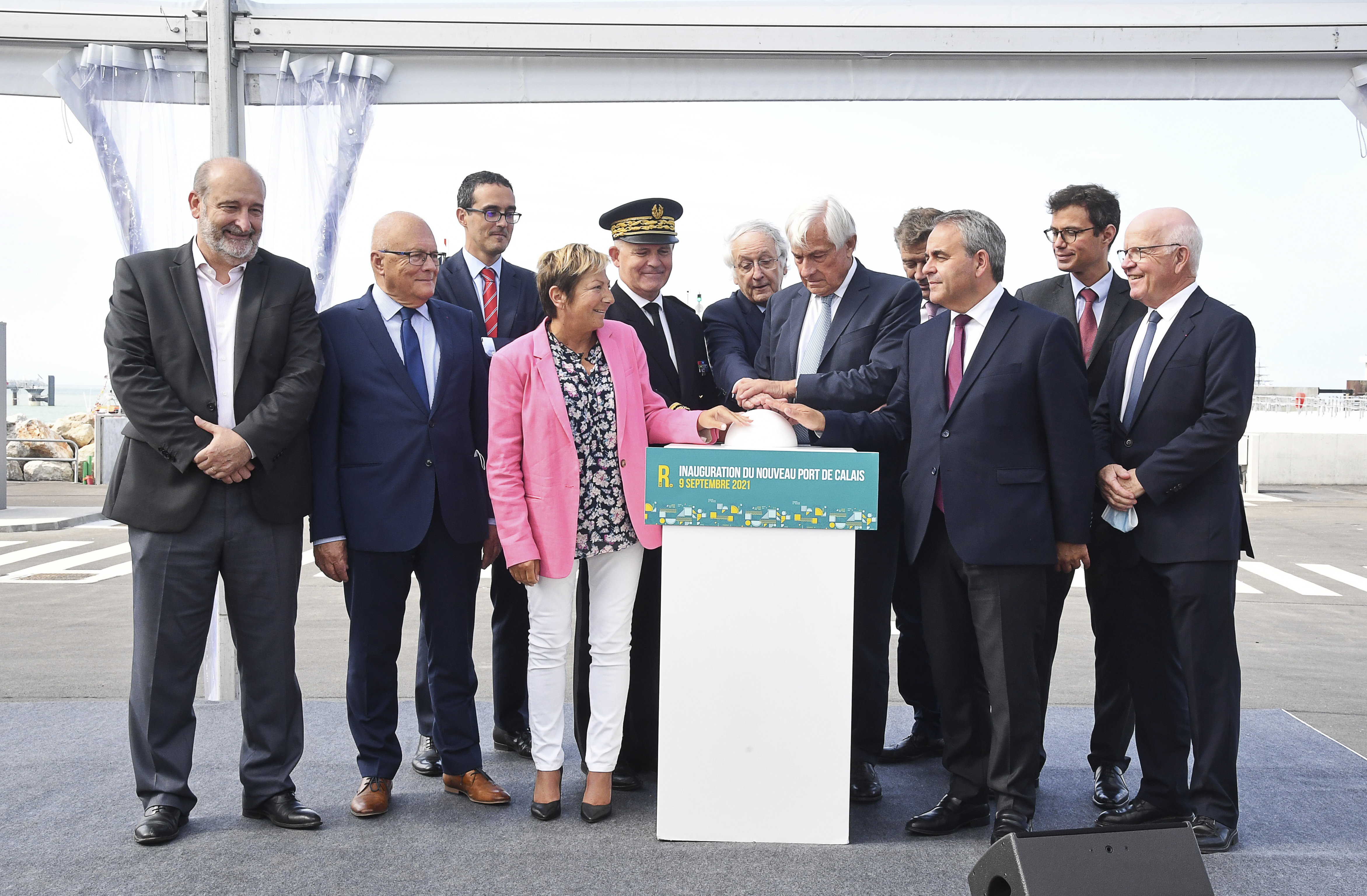
26January 2021
Results 2020: traffic is down butthe port remains solid
2020 has been a complicated year for Port Boulogne Calais, which had to deal with both the pandemic that led several European countries to restrict their nationals’ movements, which had a very negative impact on tourism, as well as the completion of Brexit at the end of the year, with uncertainty over the terms of the UK's exit from the common market, particularly for the fishing sector.
In this exceptionally difficult context where French ports have been severely affected, Port Boulogne Calais has shown its resilience by retaining top spot for French fish auction venues and leader for cross-Channel freight traffic...
20 January 2020
Port Boulogne Calais showed its resilience in a 2019 marked by a "Brexit" that broughtuncertainty and sluggish economic traffic across the Channel. The port of Calais is once again establishing itself, within this turbulent context, as the undisputed leader in cross-Channel freight traffic, while the port of Boulogne-sur-Mer retains its first place in the French fishing port rankings.
The port of Boulogne-sur-Mer: leading French fishing port in terms of valueand tonnage
Despite a slight decline of 1.9% in volumes recorded with 31 538 tonnes - which follows the downward trend of French auctions in 2019 - Boulogne-sur-Mer retains its first place in the fishing port rankings. It also maintains its first place in terms of value, despite a fall in the average price per kilo of 1.2% (2.54 euros). The total value of sales recorded in 2019 amounted to 80.3 million euros (down 2.8%).
After a rather favourable start to the year, buoyed by a good herring, whiting and mackerel season, the following months were more complicated due in part to the erratic spring weather. Sole catches, the main resource for small boats, are still in sharp decline (down 24%) while the scallop harvest was very good in 2019, up 11%. Squid remains the flagship species for Boulogne and alone accounts for almost 28% of the total value of transactions of all species combined.
The share of remote selling, introduced in 2017, continues to grow and accounted for almost 13% of the volume of auction sales, with a steady increase over the year (up 17.5%). The number of remote buyers increased in 2019 by 26%, including new foreign buyers such as Spanish, Belgian and Dutch.
At the port of Calais, cross-Channel freight and tourismtraffic had an unsettled year
Resilient HGV traffic, notwithstanding a complex situation
2019 has been a hectic year for freight traffic to and from Britain, mainly due to "Brexit" news and related uncertainties, which caused concern among market stakeholders and a decline in economic traffic across the Channel. The port of Calais was also affected by social action by customs officers, who disrupted traffic for nearly a month during the spring.
However, despite such disruption and although the Channel experienced a decline in freight traffic overall of 5%, the port of Calais held up rather well, registering the passage of 1 813 067 units (down 4.6%), representing nearly 90 000 fewer HGVs than 2018 and retaining 46% of the market share.
Tourism traffic was disappointing...
While 2018 saw continued recovery in tourism traffic that began two years ago, 2019 did not keep pace with this trend. The all-pervasive "Brexit" news in Britain, combined with an unfavourable sterling exchange rate, will undoubtedly have impacted British people's travel plans. The port handled less than nine million passengers (8 477 908), down 7% compared to 2018. The number of passenger vehicles also declined by 8.7%, with a total of 1 490 633 units (all types combined). The port of Calais remains the leader in the coach segment, despite falling by 6%.
A highly promising, positive performance forthe intermodal terminal
The intermodal terminal at the port of Calais confirmed the expected increase in its traffic in 2019.
Unaccompanied trailer traffic (without driver or tractor) continued to increase, reaching 42 483 units, an increase of 11.2% over the year. In October, a new record was set, with 4962 transshipped trailers.
This growth was supported by the ramp-up of the rolling motorways operator VIIA, which further improved its services by providing daily services (30 weekly trains) to and from Le Boulou and Orbassano from the end of 2018, and Mâcon from last March. In addition, the opening of the new Ro-ro Calais - Tilbury (London) shipping line offered by P&O ferries since the end of September 2019 and the increase in the number of trailers shipped by DFDS on its vessels also produced a healthier result in this traffic segment.
The target of "50 000 trailers" would have been met or even exceeded without the interruption of the rolling motorway lines to Le Boulou and Orbassano due to bad weather in August and October, preventing the rail operator from operating at full capacity for several weeks and further compounded by the social action throughout December, which brought rail traffic to a standstill. Despite these events, the rail operator almost doubled (up 88%) the number of trailers transported.
A mixed year on the general cargo terminals of Boulogne-sur-Mer and Calais
Despite a lack of traffic at the sugar terminal, Calais saw a slight increase of 1% compared to its 2018 level, with a tonnage of 511 836 tonnes. Among the main commodities transported are materials destined for the port extension site, petroleum coke and cables.
The Boulogne terminal, on the other hand, had a difficult first half-year and then recovered well at the end of the year, notably due to the transporting of limestone. Although total tonnage was down 12.2% at 701 539 tonnes, the Boulogne general cargo terminal has seen a marked resurgence in traffic over the past two years.
18million eurosinvestedin the two ports
With the possibility of a no-agreement Brexit result threatening, Port Boulogne Calais invested six million euros to adapt and develop its infrastructure to meet new obligations and customs controls while providing the best possible service and maintaining fluid transit for two million HGVs and nine million passengers.
In Boulogne, modernisation of the fishing port, the general cargo terminal and the Capécure fishing area accelerated in 2019. The port site benefited from nearly eleven million euros of work, notably to repair part of the lanes on the main roads, renovation and compliance work to the tidal station and refurbishment of slipway No. 2.
In 2020, the port of Boulogne will receive six million euros, including three million euros for the construction of the new fish crate washing centre and the net repair yard, which will cost a total of six million euros and whose construction began at the end of the year. 2020 will also see the completion of road refurbishment work in the Capécure area and completion of work on slipway No. 2, which will be put back into service in February.
In Calais, the work needed to put the new port into operation will be a stand-out project in 2020, as well as maintenance to the current cross-Channel terminal, at a total cost of 11 million euros.
Jean-Marc Puissesseau, President and CEO of Port Boulogne Calais, comments: "The commissioning of the new port in the first quarter of 2021 and arrival in 2022 of next-generation, larger-capacity vessels will strengthen our position as the cross-Channel leader. Moreover, the development of unaccompanied trailer traffic combined with the important maritime and rail services offered from the port of Calais now put uson the map of European intermodal hubs. We are continuing our "100 000 trailers" target transshipped from rail or road onto the Calais-Tilbury line."
Key figures 2019 | |
Total goods (Cross-Channel + General Cargo): 42 965 669 tonnes
| |
Cross-Channel traffic:
| Fishing:
|
General cargo traffic:
|
|
press contact
Isabelle Fauquet
Communications Manager / Press Relations
+33 (0)7 85 54 04 47 / +33 (0)321 462 910
isabelle.fauquet@portboulognecalais.fr
28 May 2019
Port Boulogne Calais has just obtained simultaneous certification of its management systems in the fields of Quality, Environment, Health and Safety at Work and, finally, Food Safety. It now meets the international standards ISO 9001, ISO 14001, OHSAS 18001 and ISO 22000.
After more than three years of effort, a complete overhaul of its organisation and a major commitment on the part of its employees, Port Boulogne Calais now meets the latest versions of four Quality standards of the International Organisation for Standardisation (ISO and OHSAS for the 18001 standard).
The ISO 22000 standard covers only the Boulogne-sur-Mer site, France's leading fishing port and Europe's leading seafood processing centre. This allows Port Boulogne Calais to guarantee the control of risks related to food safety for its customers in the Capécure industrial zone.
After a lengthy audit, the DNV-GL certification body has validated the standards.
Our declared ambition: to become the leading port in Europe
Port Boulogne Calais made the ambitious choice, as early as 2015 when it signed the concession contract awarded by the Hauts de France Region, to carry out a simultaneous certification programme encompassing all its activities, and on its two sites in Boulogne-sur-Mer and Calais.
As a consequence, in May 2019, it became the only European port, and this is without precedent, to obtain the quadruple certification of all its activities.
It is worth noting that ISO and OHSAS quality management standards are the most widely used standards worldwide and are based on international managerial standards.
One goal: excellence
The certifications issued cover a period of 3 years. However, Port Boulogne Calais has chosen a half-yearly audit, rather than an annual one, to ensure the continuous improvement of its organisation.
This quadruple certification is the result of long, hard work but it aims above all, for Port Boulogne Calais, to provide the best service to its customers and partners today and tomorrow with Calais Port 2015.
Our organisation wishes to go even further in its aim for excellence and will commit itself in the coming months to a process to achieve the ISO 26000 standard on social responsibility.
Jean-Marc Puissesseau, Chief Executive Officer of Port Boulogne Calais, reports: "It is a source of both very great satisfaction and very great pride. Never before has a single port in France and Europe embarked on such an ambitious certification programme. Port Boulogne Calais is becoming a real benchmark. This is how we are demonstrating our organisation's ambition and willingness to become "more than just a port".
14 January 2019
The Port Boulogne Calais is consolidating its leading position both in terms of cross-Channel traffic and in the ranking of French fishing ports. 2018 saw the return of tourist traffic on the Calais/Dover route and the continued status of the port of Boulogne as France’s leading fishing port.
The port of Boulogne-sur-Mer maintains its position in the ranking of French auction venues.
.
After a fall at the start of the year in terms of volumes recorded, the positive results for the second half of the year allowed the Boulogne-sur-Mer auction venue to maintain a level equivalent to that of 2017, with 32 142 tonnes of sales recorded in 2018 for a turnover of 82.6 million euros, up 2% compared to 2017. The average price per kilogram saw a slight increase of 1% at 2.57 euros. The large volumes of squid landed, whose average price is around 8 euros per kilo, helped maintain this average price for all species combined.
Boulogne-sur-Mer remains the premier French fishing port in terms of tonnage.
The port of Calais sees a good year for HGV traffic, despite a lack of capacity over the first six months
2018 turned out to be a year of contrasts in terms of heavy goods vehicle traffic at the port of Calais. The number of trucks registered during the first half of the year was down compared to 2017. The port of Calais only had a complete fleet of ships from July, with the return of the Pride of Kent, which had to undergo repairs due to damage in December 2017 following a storm.
Although traffic in the second half of the year was more robust when capacity returned to normal, heavy goods vehicle traffic in 2018 saw a drop of 4.5% overall with 1 900 616 units, the straits sector also experiencing a decline. The drop in the number of freight units materially impacted the volume of goods transported, which fell by 7% to give a total of 45 660 281 tonnes.
Passengers and passenger vehicles back on the Calais / Dover route
2018 saw the full resumption of Tourist traffic (passengers and vehicles), which had initially got underway in the second half of 2017. Passenger traffic passed the nine million mark, with 9 118 014 passengers, an increase of 1.41% compared to 2017.
As for passenger vehicles, the increase is even stronger, with a 5.16% increase in traffic, or 1 632 291 vehicles of all types combined: caravan traffic jumped 11% to 32 244 units, with cars up 5.60% to 1 451 438 vehicles. Only coach traffic saw a slight decline of 1.13%, but this is well below the sharp decline observed in previous years.
The renewed growth of Tourist traffic, which had declined sharply since 2014, indicates a newfound confidence among the British in travelling through the port of Calais
A fine performance for the Boulogne-sur-Mer general cargo terminal
While the total tonnage of the general cargo terminals of the Port Boulogne Calais was down by 34% with a total of 1 306 569 tonnes due mainly to the downturn in needs for the Calais Port 2015 site, the Boulogne-sur-Mer terminal fared really well and ended 2018 with an increase of 20%. This excellent progress, which has continued since 2012, is driven by substantial rock and gravel activity, as well as quicklime, which is expected to see a further increase in traffic in 2019.
In addition, the Boulogne-sur-Mer general cargo terminal gained two new cranes in 2018 that will be able to cope with the announced increase in breakbulk traffic in the years to come.
In 2018, the Port of Calais general cargo terminal handled 504 763 tonnes, mainly consisting of sand and stone, petroleum coke and limestone traffic destined for Norway and Finland.
Major investments in Boulogne and Calais:
The Port Boulogne Calais has invested nearly 15 million euros in 2018 on its two port sites. It is continuing its investment programme to make the Port of Boulogne Calais a benchmark port platform in Europe, innovative, modern and concerned with sustainable development.
The port of Boulogne-sur-Mer alone has benefited from more than 12 million euros of investment dedicated to modernising the port site, both at the fishing port, the commercial terminal and the Capécure business park. In Calais, great efforts have been made to improve the reception of travellers with new facilities and improvement of the port site.
Jean-Marc Puissesseau, President and CEO of the Port Boulogne Calais, comments: "After several years of continuous decline, 2018 saw the encouraging return of passenger traffic to the port of Calais, which remains the largest French travel port. The major investments in the modernisation of our facilities, the development of the activities of our two port sites of Calais and Boulogne and the Brexit preparations will ensure that the Port Boulogne Calais’ development is sustainable. Providing our customers with quality service is at the heart of our concerns, so we have embarked on an ambitious five-fold ISO certification process that’s unique among French ports. I can confirm that the Port Boulogne Calais is ‘more than just a port’."
Summary of key figures for 2018 | |
Total goods (cross-Channel + Trade): 46 966 850 tonnes
| |
Cross-Channel activity:
General cargo:
| Auction:
|
|
|
Press contact
Isabelle Fauquet
Communications Manager / Press Relations
+33 (0)7 85 54 04 47 / +33 (0)321 462 910
isabelle.fauquet@portboulognecalais.fr
2 April 2019
As part of post-Brexit, the port of Calais has invested 6 million euros in facilities to meet the new requirements for customs and/or sanitary and phytosanitary checks and inspections for goods passing through the port. The facilities for the SIVEP (Veterinary and Phytosanitary Inspection Service) and customs services were officially handed over this morning to the State services.
A platform in the heart of the cross-Channel terminal
Consisting of 6 loading bays for the VAPIS intended for the sanitary inspection of food products and plant checks, and 4 bays for customs controls and inspections, the platform is located as close as possible to the ship docking berths. As such, trucks to undergo checks or inspections will be directed directly to this platform as soon as they leave the ferries. The platform also has a parking area that can accommodate 50 HGVs.
This arrangement also features a livestock station for live animals (horses) and a refrigerated storage area, at the Paul Devot dock in the immediate vicinity of the port.
Given the importance of the Capecure market in Boulogne-sur-Mer - remember that it is the leading European centre for processing seafood products - trucks carrying goods from fishing (wild or farmed) from the United Kingdom can go to the SIVEP in Boulogne-sur-Mer as close as possible to the delivery and processing areas.
All these developments have been decided in consultation over many months between the port of Calais, the shipping companies and the State services.
Waiting areas for customs checks and inspections
Two zones have been created at the terminal to accommodate trucks waiting for customs clearance. The first, which will take heavy goods vehicles from landing berths 5, 6 and 7, will be able to accommodate up to 140 units simultaneously, while the second, with 50 parking spaces, is intended for heavy goods vehicles arriving at berths 8 and 9. Areas accommodating the customs services will be adjacent to these two zones. An office for the customs clerk will be located in these same premises and will offer its services for carriers to complete their formalities.
On the export side, customs clerks will also be available for carriers who have not completed their customs formalities. The offices and parking for nearly 180 trucks are located on the current "East port" near the intermodal terminal.
Jean-Marc Puissesseau, Chief Executive Officer of Port Boulogne Calais, comments: "We announced in early 2019 that our port would be ready to face the challenges of a Brexit with no agreement, and we are indeed ready! All these facilities, coupled with the "dematerialised" border developed in full cooperation with the French customs services and the shipping companies, will help keep trucks flowing smoothly and best support our customers."
18 January 2018
2017 was synonymous with recovery for the Port Boulogne Calais. On the Cross-Channel sector, heavy goods vehicle traffic continued the growth it started in 2016, but passenger traffic was not up to expectations. As for the fishing port of Boulogne-sur-Mer, it has retained its first place in the ranking of French fish auction centres in terms of volume.
Truck traffic on the rise with nearly two million vehicles transported
Although lower than forecast, heavy goods vehicle traffic continued the growth that began in the last quarter of 2016, marked by the dismantling of the La Lande camp. With 1,990,082 vehicles transported, heavy goods vehicle traffic increased by 4.25% in 2017. While this figure represents a historic record for the Port of Boulogne Calais, the market share of the heavy goods vehicle business has not yet returned to its pre-crisis level with 47% in 2017 against nearly 50% before 2015 .
A difficult yet encouraging year for passenger traffic
Cross-Channel passenger traffic was not up to expectations in 2017, and dropped 1.7% compared with 2016 figures, passing for the first time under the nine million mark with 8,990,798 passengers. However, even though traffic continued to fall in 2017, the second half of the year saw some encouraging signs of recovery that should be confirmed.
As for passenger vehicles, there was a significant decline, as in the last two years, in coach traffic.
Traffic decreased by 9% with 73,121 vehicles, de facto impacting the number of passengers carried. At the same time, the number of cars and caravans is increasing, which indicates renewed confidence among UK citizens about passing through the port of Calais. Overall passenger car traffic increased by 3.2% to stand at 1,506,681 units.
The general cargo terminals continued the growth which began in 2016
The activity of the general cargo terminals continued to make progress both in Calais and Boulogne-sur-Mer. A total of 1,995,715 tonnes were handled in 2017, which represents an increase of 8.38% compared with 2016. 1,334,060 tons (+8.9%) passed through the Calais general cargo terminal. The traffic mainly concerned construction materials, petroleum products, sugar – the traffic in which has almost doubled after the
elimination of quotas – and submarine cables. In Boulogne-sur-Mer, the annual tonnage amounted to 661,655 tonnes (+7.3%) in 2017, thanks in particular to the traffic in building materials and livestock feed products. The good growth (+30,000 tonnes) of limestone
traffic exported to the countries of northern Europe is worth highlighting. Finally, note that the experiment conducted in 2017 with quicklime traffic was conclusive. The development of this new sector should result in significant new volumes of traffic in 2018.
"Unaccompanied” trailer traffic confirmed its build-up.
"Unaccompanied" trailer traffic (i.e. with no driver) is continuing to grow, supported in part by the restart, last February, of the VIIA Britanica rail motorway linking Calais to Le Boulou (Pyrenées Orientales). For 2017, unaccompanied traffic grew by 9.8%. 41,339 units were handled at the port of Calais. The rail operator, VIIA, has planned to increase the frequency of its trains and the development of sites with rail access to Calais by the end of January 2018. The build-up in unaccompanied trailer traffic confirms the soundness of the decision taken by the Port Boulogne Calais to develop and invest in multimodal transport solutions.
The fish auction centre in Boulogne-sur-Mer keeps its place as 1st French fishing port in volume and 2nd in value
The port of Boulogne-sur-Mer in 2017 remained the largest French fishing port with 32,028 tonnes landed, which represents a 4.8% decrease compared with 2016.
On the other hand, the average selling price per kilo rose sharply to reach 2.53 euros against 2.31 euros in 2016 (i.e. +9.5%). The increase was largely due to the higher volumes landed of high value species such as squid and scallops.
As a result, the value of landed fish increased by 4.2% to stand at €81.1m in 2017, allowing the port of Boulogne-sur-Mer to maintain its 2nd place in value.
Jean-Marc Puissesseau, Chairman and CEO of Port Boulogne Calais said: "The figures for 2017 are not up to our expectations. 2017 was a mixed year for the Port Boulogne Calais with a relative recovery in heavy goods vehicle traffic, but not in passenger traffic. The management and our employees continue to work every day to improve the quality of the reception of our customers and users on our infrastructures both in Boulogne and Calais.
The expected growth in freight traffic on both sides of the Channel in the coming years proves that the Calais/Dover route, the shortest and most economical, remains a strategic choice for the transport and logistics industry. It is essential for the port of Calais and its hinterland that the fluidity of traffic on the Calais/Dover route be maintained and that the ongoing discussions between Europe and the UK with regard to Brexit take this into account."
Calais – 25th April 2017
Today, the Port Boulogne Calais unveils its activity figures for the first trimester of 2017 for the port of Calais. After a difficult year in 2016, professionals have affirmed, through their strong comeback, a renewed confidence in the services of the Calais installations.
An absolute record for freight traffic for the month of March
The renewed pickup of freight traffic has been confirmed in the first trimester of 2017 and allowed the port of Calais to realise the best trimester in its history through an absolute record for the month of March and the passage of 181.005 cargo units which used the Calais port facilities. The number of lorries crossing through the port of Calais grew by 11,2% compared to the first trimester of 2016, with 507.850 heavy goods vessels passing through the port.
As further encouragement for the beginning of the year, unaccompanied freight traffic also increased by 13% compared to 2016 with more than 1.000 additional trailers handled by the port services.
This record for traffic in lorries allows the port of Calais to consolidate its position as the uncontested leader in cross-Channel freight traffic, with a market share of 47,72%.
Jean-Marc Puissesseau, President-Director of the Boulogne Calais Port, declared: “We are pleased with the very encouraging freight results which were obtained thanks to the efforts taken to ensure the security of all users and the fluidity of traffic. This increase further reinforces the need to adapt our infrastructure to these new volumes of traffic through Calais Port 2015.
We hope that the renewed confidence of professionals will also manifest itself among tourists so that the Port of Calais continues to be the privileged point of passage for exchanges with Great Britain, as much as for freight as for passengers.”
Summary of key figures for the first trimester 2017
Traffic of travellers: 1.532.011 travellers
Coach traffic: 12.234 coaches
Traffic of lorries: 507.851 vessels
Tourist vehicles: 179.973 vehicles
25 August 2015
After signing with the Nord-Pas de Calais Region the delegated public service concession agreement for the unified port of Boulogne-sur-Mer Calais on 19 February, the new concession operator, Société d’Exploitation des Ports du Détroit (Straits Port Operations Company), has become the operator of the Boulogne-sur-Mer and Calais ports since 22 July 2015.

A new 50-year concession arrangement
The Region entrusts the concession operator, Société d’Exploitation des Ports du Détroit, with management, operation, maintenance and infrastructure and superstructure development for the single port. The concession arrangement was signed for a term of 50 years.
Société d’Exploitation des Ports du Détroit chose an innovative shareholder structure associating its employees, who will own almost 5% of the capital, with the Opal Coast Chamber of Commerce and Industry, the Chamber of Commerce and Industry of the Nord de France Region, CDC Infrastructure and Meridiam.
Boulogne Calais Port: a single port
The concession agreement makes the Boulogne-sur-Mer and Calais facilities a Single Port. The development strategy should allow a balanced rapid expansion of the two facilities and ensure complementarity of their activities:
- At Boulogne-sur-Mer, it consecrates the port's position as leader in the fields of fishing and seafoods, through new investments to upgrade its fishing industry facilities.
- At Calais, the new concession arrangement allows the implementation of "Calais Port 2015", a major port infrastructure designed to strengthen the European integration of the facility and its position as leader in the cross-Channel transport of passengers and cargo.
Jean-Marc Puissesseau, President of Société d’Exploitation des Ports du Détroit, says: "The transfer of operations is a highlight in the life of the ports of Boulogne-sur-Mer and Calais. This is the starting point of a new adventure which will enable these two ports to form a single, coherent whole"…
Press contact:
Isabelle Fauquet
Tél : 03 21 46 29 10 / GSM : 07 85 54 04 47
30 January 2015
Following on from 2013, when the Port of Calais regained its best traffic levels of the past despite the global economic slowdown, in 2014 the significant upswing in business for the Port of Calais was confirmed, and it beat its previous cargo traffic record.
2014, a record year
Overall freight traffic figures for the Port of Calais in 2014 indicate more than 43 million tonnes transported (43,273,341 tonnes), representing an increase of 5% compared with 2013, the port’s best-ever year for freight traffic.
In 2014 the Port of Calais was boosted by the UK economic recovery which began in 2013; cross-Channel freight traffic alone amounted to 42,719,266 tonnes, wiping out the records of 2006 and 2007.
Press contact:
ISABELLE FAUQUET
Tel: +33 (0)3 21 46 29 10
Mobile: +33 (0)7 85 54 04 47
Isabelle.fauquet@calais-port.fr
31 January 2015
At the Shortsea Night held on 10 December 2014 in Paris with the National Maritime Museum as the prestige backdrop, the Port of Calais was distinguished for its rail superhighway terminal project which won the Shortsea & Intermodal Transport Trophy in the “Port” category.
During the evening, organised by the BP2S Association (Shortsea Shipping Promotion Centre), which works to promote shortsea transport and combined transport modes, the Port of Calais received tribute for its initiatives in favour of the modal shift and especially for its planned rail superhighway terminal on the Le Boulou – Calais line.
As their name suggests, the Trophies reward shortsea and intermodal transport initiatives. Six prizewinners received awards during the evening, in six categories: shipowner, shipper, multimodal, initiative, personality and port. It was in the latter category that the Port of Calais and its partner VIIA were distinguished.
Mr Laurent Devulder for the Port of Calais and Mr Le Guilloux for VIIA (on the left) in company of the 2014 Shortsea Night prizewinners.
Mr Laurent Devulder for the Port of Calais and Mr Le Guilloux for VIIA (on the left) in company of the 2014 Shortsea Night prizewinners.
With regard to the project itself, the Opal Coast Chamber of Commerce and Industry, concession operator for the Port of Calais, will be in charge of the developments required for the installation of a multimodal terminal in the centre of the port facilities. The terminal will be sized to accommodate two to three daily round trips between the Port of Calais and the terminal of Le Boulou (Perpignan) in southern France.
The service will be operated by VIIA, a subsidiary of SNCF - GEODIS, which will thus offer a complementary service to all-road transport on the highly saturated north-south route.
The forecast annual traffic for initial operation is estimated to be two trains per day, or 37,000 semi-trailers transported. The forecast long-term goal is to transport over 55,000 semi-trailers per year.
For the Port of Calais, which obtained PERS ECOPORTS recertification in the autumn for the third time running, this investment demonstrates its strong commitment to integrate a sustainable development strategy in each of its projects. The Le Boulou - Calais rail superhighway will allow tens of thousands of trucks each year to travel by rail and thus help decongest roads and reduce CO2 emissions.
Furthermore, at the local level the project will help stimulate the goods handling sector at the port, and will generate new jobs.
Work is scheduled to begin early in 2015, and commissioning of the service is scheduled for the last quarter of 2015
Contact:
ISABELLE FAUQUET
Tel: +33 (0)3 21 46 29 10
Mobile: +33 (0)7 85 54 04 47
Isabelle.fauquet@calais-port.fr
25 January 2017
The port of Calais has opened earlier this week its new facility for unaccompanied trailers. This upgraded service is now entirely managed by an innovative collaborative information system.
The adaptation of the site and the development of the new intelligent traffic management system, which required many months, now allows the port of Calais to propose a better service to road haulage companies guaranteeing time savings and the optimal traceability of their trailers.
This service is available to all transport companies for their trailers travelling without tractor and driver, whether local of international, and using road, rail and maritime transport modes.
A new smart storage area available 24/7
Totaling and available space of 10 500 sqm, the new parking area for UK-bound unaccompanied trailers was built within close vicinity of the T4 RoRo linkspan and the VIIA rail motorway terminal.
Equipped with a license plate reading system at the site’s entrance, this new equipment is entirely automated and accessible through a dedicated itinerary, opened 24/7 and separated from regular traffic flows.
The already existing import parking area, which welcomes trailers bound to Dover, was also modernized and equipped with automated gates.
E-modal: the innovative collaborative information system at the heart the service
E-modal is the non-visible but essential element of the new system: a dematerialized data-sharing tool, tailor-made to manage unaccompanied traffic on the port of Calais.
E-modal operates as a genuine single desk gathering all the actors of the supply chain – transport companies, shipping and handling services, maritime companies, Harbour Master, border control Authorities, etc. – this new innovative tool allows an entirely dematerialized management of unaccompanied trailers. It makes it possible to remotely control the entire process from the bookings, the handling and all the way to the boarding of unaccompanied trailers onto ferries or trains.
A guarantee of better reliability and traceability, E-modal will help to improve the logistical performance of transporters as well as the optimization of driving times and drivers’ allocation.
Thanks to the new dedicated access route, drivers will no longer need to check in with maritime companies nor at the border and security check points as these will be entirely managed by personnel of the Port Boulogne Calais during the shunting to the cross-channel terminal.
Requiring a total investment of 1,5 million Euros, this new equipment received the financial support of the European Union through the BRIDGE project.
According to Jean-Marc Puissesseau, CEO of the Port Boulogne Calais « The reorganization and modernization of the management of unaccompanied trailers prefigures the future modes of logistical management. Improved fluidity, traceability and security, these are the expressed needs of road haulage companies that we are dedicated to fulfil.
This new tool to support intermodality is essential in order to stimulate the adoption of transport and logistical modes ever more efficient and durable and which will be fully integrated in the future Calais Port 2015 infrastructure. »
Press Contacts
Isabelle FAUQUET
Tel : +33 7 85 54 04 47
isabelle.fauquet@portboulognecalais.fr
Xavier DECRAMER
Tel : +33 6 04 67 36 46
13 January 2017
Calais, 13 January 2017
The Port Boulogne Calais published today its results for 2016. A globally difficult year, in particular with regards to cross-channel traffic, but with a progressing fourth quarter bringing hope for 2017.
A particularly difficult year for passenger traffic
As a direct consequence of the incidents linked to the important migrant population in the Calais area, car traffic suffered and important drop compared to 2015 with reduction of its volume by 6,96%.
This trend can also be noticed on passenger traffic, dropping by 6,8% at 9,090,694 passengers as well as coaches down by 8,3% with only 80,448 vehicles. As it stands the Port Boulogne Calais has fallen short in 2016 of 112,052 cars, 695,559 passengers and 7,269 coaches compared to 2015.
A market share loss on cross channel freight
Lorries travelling to and from Great Britain through Calais have also suffered from the strong presence of migrants around the port until October.
The Port Boulogne Calais lost some market share as it only managed to grow its freight traffic by 3,38% with 1,909,011 travelling through the port while the market grew overall in 2016 by 6%.
A healthy performance of commercial terminals
While we suffered from important losses over the past years, the activity of the commercial terminals both in Boulogne and Calais showed promising results in 2016. Stimulated by the important needs of the Calais Port 2015 construction site, the commercial activity closed the year with a total volume of 1,224,978 tons handled while Boulogne showed a total volume of 616,367 tons.
Boulogne maintains its position as France’s n°1 fishing port in volume and n°2 in value
Despite a drop of 6,2% of its volume, the port of Boulogne remained France’s number 1 fishing port in 2016 with 33,628 tons of fish. A volume loss that was partially counterbalanced by increase of average price per kilo of 5% thanks to two great months in November and December and which allowed the port to maintain its rank as France’s second biggest fishing port in value with revenues of 77,8 million euros.
Jean-Marc Puissesseau, CEO of the Port Boulogne Calais declared: « 2016 was a deceiving year despite the good performance of the fishing activity in Boulogne and the outstanding results of our commercial terminals.
The dismantling of the migrant camp in Calais allows us to be more hopeful for 2017 but we must recognise that the situation around the port prevented our services from operating under normal conditions for most of 2016.
I remain confident in our capacity to innovate and get back on our feet. The upcoming restart of the Le Boulou-Calais rail motorway by VIIA as well as the important efforts made by our team to improve the overall quality of our services gives us reasons to be hopeful in our capacity to regain our market share in 2017.
Press contacts
Isabelle FAUQUET
Tel : +33 7 85 54 04 47
isabelle.fauquet@portboulognecalais.fr
Xavier DECRAMER
Tel : +33 6 04 67 36 46
24 October 2015
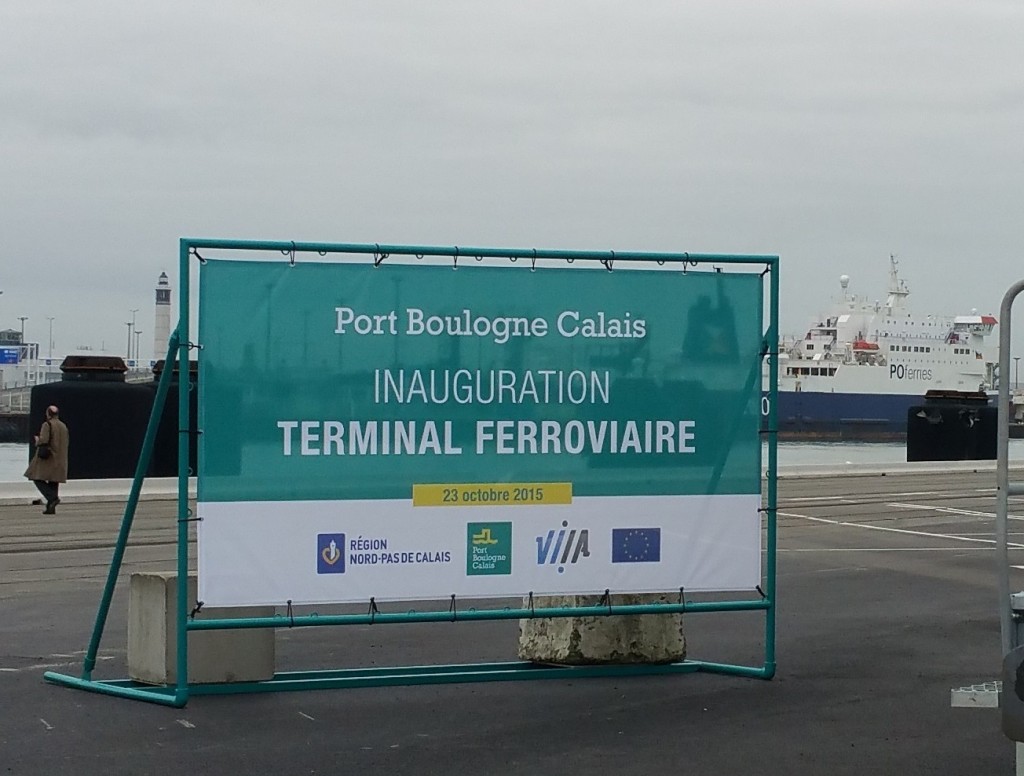 The rail superhighway terminal is the first stepping stone in Boulogne Calais Port's strategy with a view to developing the transport of unaccompanied semi-trailers. The new VIIA Britanica line operated by VIIA will open as of January 2016, connecting the Port of Calais with Le Boulou, on the French-Spanish border.
The rail superhighway terminal is the first stepping stone in Boulogne Calais Port's strategy with a view to developing the transport of unaccompanied semi-trailers. The new VIIA Britanica line operated by VIIA will open as of January 2016, connecting the Port of Calais with Le Boulou, on the French-Spanish border.
Boulogne Calais Port, the Regional Council of Nord-Pas de Calais and VIIA, a subsidiary of SNCF Logistics, this morning inaugurated the new rail terminal in the Port of Calais. This rail terminal will allow the entry into service as of January 2016 of the Le Boulou – Port of Calais rail superhighway, officially initiated in September 2013 by Frédéric Cuvillier, French Minister of Transport at that time. The superhighway will connect Spain to the United Kingdom directly in unaccompanied cargo mode.
The first European port equipped with a latest-generation rail terminal
Co-financed by Boulogne Calais Port and the European Union via the BRIDGE1 programme backed by the Nord-Pas de Calais Region, the rail terminal required a capital investment of €7 million. This new facility increases the attractiveness of the port, the first in Europe to be provided with such a terminal.
The port site has been redesigned to receive the new platform and allow smoother travel on site. A new zone has also been created to receive trains from the eastern Pyrenees directly at the port. All the customary checks will be performed on all the semi-trailers unloaded from the trains before they are transferred to their end destination.
A new innovative trans-European transport service, adding to the VIIA network.
The new rail terminal has been especially designed to receive new-generation wagons. These new side-loading UIC wagons, built by French company Lohr Industrie, simplify and speed up loading and unloading operations, since the trailers are drawn directly onto the wagons and no longer hoisted by crane.
Thanks to this technology, all types of semi-trailer meeting European standards, reinforced or not, can be received, because it is no longer necessary to proceed by vertical loading. This innovative technology makes the new VIIA Britanica service accessible to all transport operators.
Installed for the first time in a port, this new terminal is a rail, sea and road modal interchange hub for unaccompanied semi-trailers travelling from Spain to the United Kingdom, or to northern France and Belgium.
A reduction in CO2 emissions of almost 50,000 tonnes per year
The new VIIA Britanica service between Le Boulou and the Port of Calais will be the longest rail superhighway in Europe (1,200 km of road travel avoided). 40,000 trailers will be able to be transferred from road to rail each year, which represents a reduction in road congestion (50 million truck-km avoided) and a reduction in CO2 emissions of almost 50,000 tonnes per year.
The opening of this terminal and the entry into service of VIIA Britanica on 12 January next represents a further stage in the construction of the VIIA network.
VIIA Britanica is the third rail superhighway line in France, added to the lines already existing between Bettembourg (Luxembourg) and Le Boulou, and between Aiton (near Chambéry) and Orbassano (near Turin).
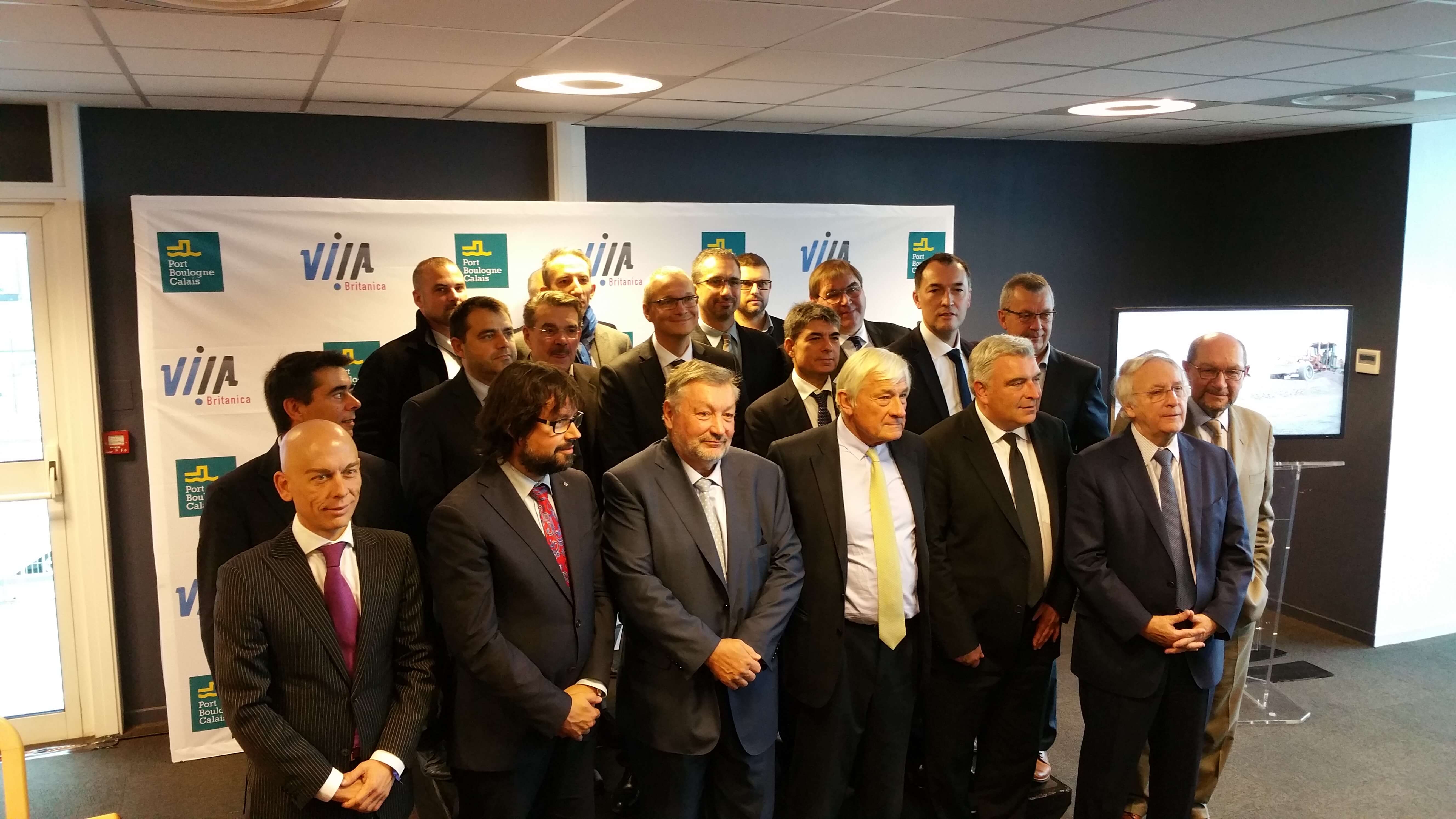 Jean-Marc Puissesseau, President of Boulogne Calais Port, said: "We are proud to be the first European port equipped with a terminal of this type. This investment opens up development prospects for the port and prefigures the port's expected growth due to “Calais Port 2015“.
Jean-Marc Puissesseau, President of Boulogne Calais Port, said: "We are proud to be the first European port equipped with a terminal of this type. This investment opens up development prospects for the port and prefigures the port's expected growth due to “Calais Port 2015“.
Thierry Le Guilloux, President of VIIA, said: "We are delighted by the opening of this terminal, which attests the vision that we share with Boulogne Calais Port, of expanding the cross-Channel traffic of semi-trailers in unaccompanied mode, by connecting rail superhighways and maritime superhighways."
The European "BRIDGE" project (Building the Resilience of International and Dependant Gateways in Europe) aims to adapt port infrastructure to the growth in freight traffic (estimated at 40% by 2030 on the Calais-Dover sea link). The ports of Calais and Dover benefit from this via the partnership organised with the Nord-Pas de Calais Region.
7 November 2016
The Port Boulogne Calais expands today its Wi-Fi service for the 10 million passengers who travel every year through the port of Calais.
Wi-Fi has been provided on the port since 2010 and is now accessible free of charge on the entire cross channel terminal as well as in the waiting areas. The expansion of the zone covered by free Wi-Fi will be particularly useful for passengers, tourists and professionals as few of them have a French mobile contracts allowing mobile internet access.
With a total bandwidth of 200Mb/s, the free Wi-Fi network will allow up to 750 simultaneous connections. A « roaming » system has been set up to allow travellers to move freely within the port without having to reconnect their Wi-Fi.
With 10 million international passengers per year and 1.8 million lorries coming from all over Europe, the port adapted its Wi-Fi offer with a portal accessible in the five most used languages by its clients: French, English, Spanish, German and Polish.
How does it work?
Accessible to all through the domain calaisport_freewifi, passengers will simply have to register once and will be automatically recognised in the future. This will be particularly appreciated by lorry drivers who regularly travel between Calais and Dover.
An additional service offered by the port of Calais to its users
The port of Calais was one of the first ports to offer Wi-Fi already back in 2010. This service was at the time only accessible in limited areas. The Atlanteam company was selected to expand the service to the entire cross-channel terminal following a public tender launched in May 2016. The improvement of the Wi-Fi required an initial investment of close to 100,000 euros excluding annual maintenance and subscription fees.
According to Jean-Marc Puissesseau, Chief Executive Officer of the Port Boulogne Calais: « the expansion of the Wi-Fi is a very good news for the Port Boulogne Calais and demonstrates our dedication to better answer the needs of our users. This improved service will be particularly useful to our professional clients to stay connected during their waiting time as well as to passengers who will be able to freely surf the internet while in the port. »
PRESS CONTACTS
Isabelle Fauquet
Tel: +33 (0)7 85 54 04 47
isabelle.fauquet@portboulognecalais.fr
Xavier Decramer
Tel: +33 (0)6 04 67 36 46
calais@eurosagency.eu
26 September 2016
The first symbolic stone of Calais Port 2015 was laid on Monday, September 26, 2016 in the presence of Francois Hollande, President of the French Republic, Xavier Bertrand, President of the Hauts-de-France Regional Council, Natacha Bouchart, Mayoress of Calais, Jean-Marc Puissesseau, President of the Strait Ports Operating Company (SEPD), Patrick Vandevoorde, President of the Strait Ports Company (SPD) and Philipe Bonnave, CEO of Bouygues Construction.
Conceived in 2002, at the initiative of the Chamber of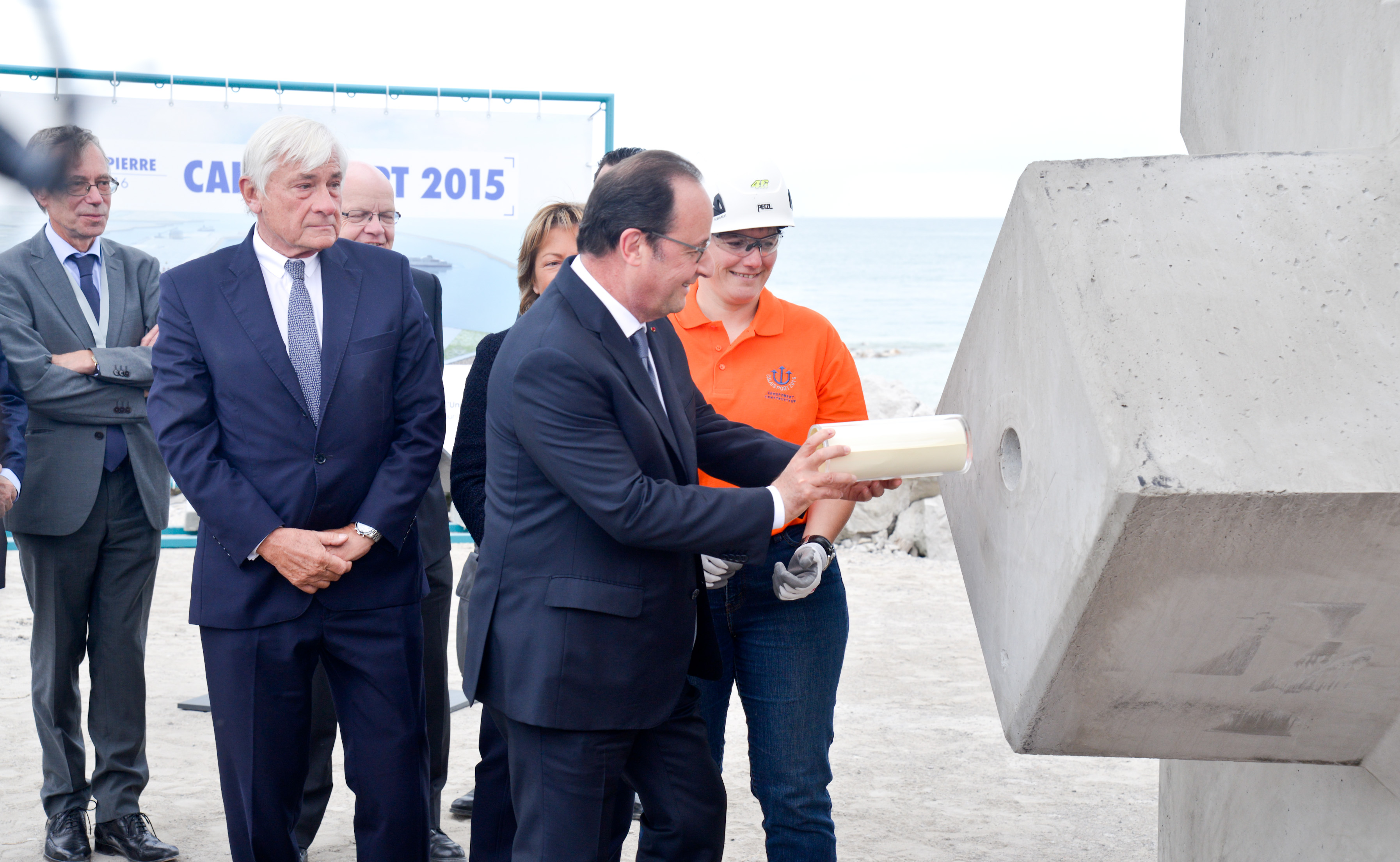 Commerce and Industry of Calais, then the concession holder for the Port with major support from the Hauts-de-France Regional Council, Calais Port 2015 has now entered its implementation phase. As the largest priority shipping infrastructure of the European Union, the project will double the current capacity of the port of Calais. Designed to anticipate and adapt to the forecast growth in traffic, this new infrastructure also prepares the Port of Calais for the logistic and industrial needs of tomorrow.
Commerce and Industry of Calais, then the concession holder for the Port with major support from the Hauts-de-France Regional Council, Calais Port 2015 has now entered its implementation phase. As the largest priority shipping infrastructure of the European Union, the project will double the current capacity of the port of Calais. Designed to anticipate and adapt to the forecast growth in traffic, this new infrastructure also prepares the Port of Calais for the logistic and industrial needs of tomorrow.
Mr Jean-Marc Puissesseau (on the left), President of the Société d'Exploitation des Ports de Détroit and M. François Holland, (on the rigtht) President of the French Republic.
Laying the foundation stone for Calais Port 2015 is the symbol of a visionary project and the backbone for genuine economic drive in the Hauts-de-France region with an investment of over € 863 million and the creation of 2,000 direct, indirect and induced jobs.
On this occasion and to officially launch the construction site, the main partners in the project signed a symbolic deed which was then sealed inside a concrete X-block, an emblematic component of the construction site mainly used to build the future breakwater.
Building Today the Cross-Channel Port of Tomorrow
The flagship of French ports, the largest port in continental Europe for passenger transport, the 4th largest French port for goods, but also the 2nd largest Roll-on/Roll-off port in Europe, the port of Calais welcomes 10 million passengers, 2 million lorries and 41.5 million tonnes of cargo per year. It had to absorb the forecast growth in Channel traffic, which was the challenge that Calais Port 2015 is designed to meet
Expected to last six years, the Calais Port 2015 construction site will enable the port of Calais to adapt to future port issues and strengthen its position as market leader, in particular by creating a new 90-hectare harbour basin and an emblematic seawall over three kilometres long. In the first phase, three new ferry berths will also be created and a Roll-on/Roll-off loading station, scheduled for commissioning in 2021. These new facilities will be scalable as new business activities emerge, enabling the port of Calais to remain on the leading edge of global standards. The work will be carried out by a consortium made up of specialized business units of the Bouygues group, Spie Batignolles and Jan de Nul.
Sustainability issues integrated into the project as of the design stage
Eco-designed Calais Port 2015 also meets the commitments in terms of the preservation local flora and fauna taken by the Hauts-de-France Regional Council during the public enquiry and before the National Council for the Protection of Nature.
The scheduling in particular has been specifically implemented to avoid interventions that disturb fauna during breeding and migration periods, and to preserve nesting areas suitable for birds.
Public-Private funding of € 863 million
The financing for the project of € 863 million has been provided by the Strait Ports Company (SPD), owned by the French long-term investment fund Meridiam (40%), the French Consignments and Loans Fund CDC (40%) the Opal Coast Chamber of Commerce and Industry and the Northern France Regional Chamber of Commerce and Industry (19%) and the Port of Dunkerque (1%).
Apart from the shareholders who have contributed € 89 million in equity and quasi-equity capital, three major financial partners are involved in the project: AllianzGI (which has underwritten a bond issue for € 504 million on behalf of the Allianz Group and third-party investors), the European Investment Bank, and Crédit Agricole Corporate Investment. Public funds amounted meanwhile to € 270 million, pre-financed in full by the Hauts-de-France Regional Council (including € 98.6 million from the European Union).
With an investment of 863 million euros, the project is one of the main French investment projects and will generate significant economic benefits for all the regions and local authorities on the Opal Coast.
If you want some pictures of the project, do not hesitate to contact us :
PRESS CONTACTS
PORT OF BOULOGNE CALAIS
Isabelle Fauquet
Tel: +33 (0)7 85 54 04 47
isabelle.fauquet@portboulognecalais.fr
Xavier Decramer
Tel: +33 (0)6 04 67 36 46
calais@eurosagency.eu
HAUTS-DE-FRANCE REGIONAL COUNCIL
Peggy Colette
Tel: + 33 (0)6 75 93 38 28
peggy.collette@nordpasdecalaispicardie.fr
STRAITS PORT COMPANY
Luc Herchin
+33 (0)6 31 73 79 99
l.herchin@spd-calais.com
DESIGN-BUILD CONSORTIUM
Matthieu Carre
+33 (0)1 30 60 66 39
m.carre@bouygues-construction.com
19 February 2015
On 19 February 2015, the Nord-Pas de Calais Region, owner of the ports of Calais and Boulogne-sur-Mer, and Société d’Exploitation des Ports du Détroit signed the new Concession Agreement for the ports of Boulogne-sur-Mer and Calais, for a term of 50 years, in the presence of representatives of the Region and the local authorities concerned, the shareholders of the two companies (Operating and Project), the contractors who will be in charge of carrying out the work on the extension to the Port of Calais "Calais Port 2015", and the financial institutions backing the investments.
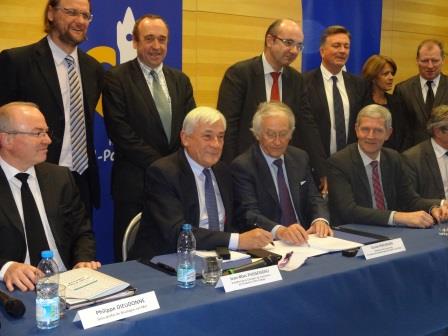 Mr Jean-Marc Puissesseau (on the left), President of the new Société d'Exploitation des Ports de Détroit and Mr Daniel Percheron (on the right), president of the Nord-Pas de Calais Regional Council, sign the single port concession agreement for the next 50 years.
Mr Jean-Marc Puissesseau (on the left), President of the new Société d'Exploitation des Ports de Détroit and Mr Daniel Percheron (on the right), president of the Nord-Pas de Calais Regional Council, sign the single port concession agreement for the next 50 years.
The new 50-year concession transforms the Boulogne-sur-Mer and Calais facilities into a single port.
It helps strengthen the leading position of Boulogne-sur-Mer in the fishery and seafood markets, with new investments to upgrade the facilities for the fishing industry in terms of services to fishermen as well as product logistics:
- Investments in the “port of the future”’ and sustainable development, to anticipate the future refuelling needs of fishing vessels and innovative energy charging systems, and also to adapt the facilities in order to reduce discharges into the sea;
- Investments to develop the tourism, yachting and cruise markets;
- Investments to develop fishing, the Capécure enterprise zone, and fishing and logistic operations;
- To these investments will be added direct investments by the Region.
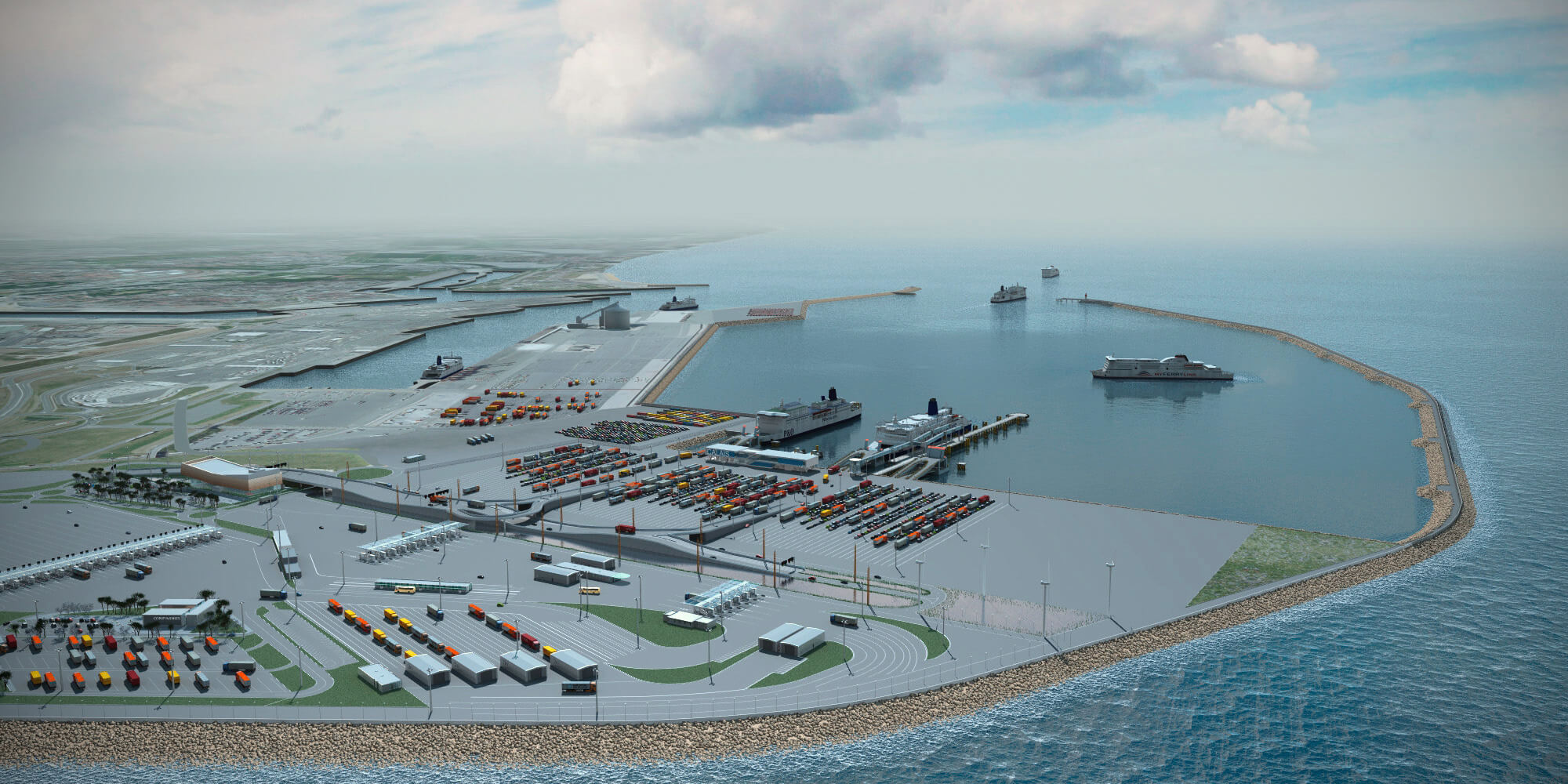 In Calais, the new concession will enable completion of the "Calais Port 2015" project, representing an investment of about €650 million. The project involves:
In Calais, the new concession will enable completion of the "Calais Port 2015" project, representing an investment of about €650 million. The project involves:
- The creation of a new seawall about 3 miles long and a dock with a surface area of 90 hectares essential to any development of the Port of Calais;
- The creation of 44 hectares of new quayage using material dredged from the dock, in a balanced cut-and-fill approach;
- The construction of berths for the latest-generation mega-ferries;
- The developments required for road and rail connections;
- A rail/road/sea terminal at the contact point of the future rail and maritime superhighways from southern France, but also from the rest of Europe.
Complementary skills and the participation of Europe
The signing of the Concession Agreement was made possible by a combination of complementary skills: those of the Opal Coast Chamber of Commerce and Industry, the Regional Chamber of Commerce and Industry, the Port of Dunkirk (Grand Port Maritime de Dunkerque), the investors CDC Infrastructure and Meridiam, those of the design and construction consortium, formed by companies from the Bouygues, Spie Batignolles and Jan de Nul groups, and those of the financiers: Allianz GI, who accepted the principle of participation in the project on behalf of the Allianz Group and third-party investors by underwriting a bond issue for €525 million, in addition to the contribution of more than €117 million by equity investors, and the support of the European Investment Bank.
These commitments reduced the total amount of subsidies to €270 million. In addition, the French government decided to participate in financing the port and Europe showed its willingness to do the same.
The development strategy for the two ports is that of a single port enriched by the potential of both the facilities.
The aim is to balance the development of the two ports by developing the complementarity of their operations, and complementarity in general between the ports on the Opal Coast and the Channel Tunnel. The establishment of the delegated public service contract will help develop the economy of the Opal Coast and of the region as a whole, through job creations and new tax revenues for the local authorities.
The decision taken by the Nord-Pas de Calais Region and the signature of the concession agreement mark an historic step for the Opal Coast, the Nord-Pas de Calais region, for France and for Europe.
Press contacts:
Nord-Pas de Calais Regional Council: Peggy COLLETTE
Peggy.collette@nordpasdecalais.fr /+ 33 (0)3 28 82 53 03
Opal Coast CCI: ISABELLE FAUQUET
Isabelle.fauquet@calais-port.fr / + 33 (0)3 21 46 29 10
CDC Infrastructure: Marie-Laure MAZAUD
marie-laure.mazaud@cdcinfra.com / + 33 (0)1 58 50 53 08
Meridiam: Virginie BRANGER
vbranger@volcancommunication.fr / + 33 (0) 6 61 51 52 03
20 January 2016
Indeed, 2015 was an exceptional year in several respects, but especially from the organisational viewpoint. Since 22 July last, the ports of Boulogne and Calais have been united in a single company, and their fates are now more closely linked than ever.
At Calais, a relative stability despite an extremely difficult environment
After a start of year which pointed to record results in 2015, the activity of the Port of Calais fully incurred the consequences both of the disturbances due to the end of the MyFerryLink operations and those due to the massive influx of migrants looking to reach the United Kingdom.
These disturbances did not prevent Calais from remaining a leader in cross-Channel freight traffic.
Press contact:
ISABELLE FAUQUET
+ 33 (0)7 85 54 0 47 / + 33 (0)3 21 46 29 10


